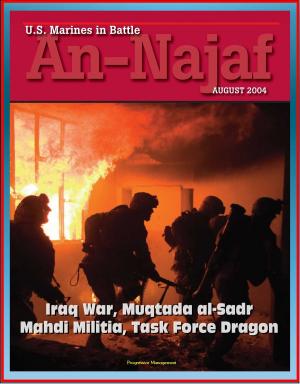Red Teaming: Past and Present - Case Studies: Field Marshal Slim in Burma, T.E. Lawrence in World War I, Operation Iraqi Freedom, Decision-Making Theory, Challenging Organization's Thinking
Nonfiction, History, Military, World War I| Author: | Progressive Management | ISBN: | 9781310627132 |
| Publisher: | Progressive Management | Publication: | March 25, 2016 |
| Imprint: | Smashwords Edition | Language: | English |
| Author: | Progressive Management |
| ISBN: | 9781310627132 |
| Publisher: | Progressive Management |
| Publication: | March 25, 2016 |
| Imprint: | Smashwords Edition |
| Language: | English |
Professionally converted for accurate flowing-text e-book format reproduction, this study examines historical and contemporary uses of the core concepts of red teaming, and determine the value of using the concept of red teaming in decisionmaking. Studying how great commanders in history used the core principles of red teaming may help solidify the U.S. Army's red teaming doctrine. Therefore, this monograph compares the success of past "great captains" of warfare against relatively modern military failures of the U.S. Army in order to determine the necessity of using the core concepts of red teaming in the current U.S. army and Joint decision-making processes. To this end, this monograph presents three case studies to analyze military campaigns that successfully used the core concepts of red teaming and campaigns that did not. Each case study evaluates the extent to which the campaign included the core concepts of red teaming, and their implication on the campaign's outcome.
The first two case studies, Field Marshal Slim's 1945 counteroffensive into Burma and T.E. Lawrence's participation in the Arab Revolt during World War I, demonstrate how applying the core concepts of red teaming enabled each commander to develop a better understanding of their operating environment and subsequently achieve success. The final case study presented in this monograph, Operation Iraqi Freedom, demonstrates the dangers of misapplying the core concepts of red teaming, and emphasizes the importance that realism and accuracy plays in using alternative perspectives and divergent analysis.
This monograph concludes that using the core concepts of red teaming, namely challenging the organization's thinking, incorporating alternative analysis and incorporating alternative perspectives, can significantly improve understanding of the operating environment, which is critical to achieving success on the modern complex battlefield. Therefore, this monograph recommends that U.S. Army and Joint doctrine incorporate red teaming concepts throughout their respective decision-making processes.
As warfare continues to become more complex due to the advent and proliferation of new technology, blending of ethnic and cultural groups, population growth and urbanization, and tendency towards asymmetric warfare, commanders will have more difficulty in understanding the battlefield and ultimately achieving success. Only through a complete understanding of the operating environment from the perspective of the U.S., its adversaries, and local inhabitants of the operational area combined with critical analysis in decision making and planning can the U.S. Army successfully accomplish the diverse and complex missions looming in the future. One proposed method for achieving this understanding is the concept of "red teaming".
The term "red team" is a relatively new buzzword used in military and civilian enterprises. However, there is no common understanding of what red teaming means. Red teaming can mean role-playing the adversary, conducting a vulnerability assessment to determine weaknesses, or using analytical techniques to improve intelligence estimates and intelligence synchronization. While these definitions seem unrelated, they have in common the ultimate goal of improving decision making through critical thinking and analysis. This commonality forms the basis of the U.S. Army understanding of red teaming. The U.S. Army defines red teaming as "a function executed by trained, educated, and practiced team members that provides commanders an independent capability to fully explore alternatives in plans, operations, concepts, organizations, and capabilities in the context of the operational environment and from the perspectives of our partners, adversaries, and others."
Professionally converted for accurate flowing-text e-book format reproduction, this study examines historical and contemporary uses of the core concepts of red teaming, and determine the value of using the concept of red teaming in decisionmaking. Studying how great commanders in history used the core principles of red teaming may help solidify the U.S. Army's red teaming doctrine. Therefore, this monograph compares the success of past "great captains" of warfare against relatively modern military failures of the U.S. Army in order to determine the necessity of using the core concepts of red teaming in the current U.S. army and Joint decision-making processes. To this end, this monograph presents three case studies to analyze military campaigns that successfully used the core concepts of red teaming and campaigns that did not. Each case study evaluates the extent to which the campaign included the core concepts of red teaming, and their implication on the campaign's outcome.
The first two case studies, Field Marshal Slim's 1945 counteroffensive into Burma and T.E. Lawrence's participation in the Arab Revolt during World War I, demonstrate how applying the core concepts of red teaming enabled each commander to develop a better understanding of their operating environment and subsequently achieve success. The final case study presented in this monograph, Operation Iraqi Freedom, demonstrates the dangers of misapplying the core concepts of red teaming, and emphasizes the importance that realism and accuracy plays in using alternative perspectives and divergent analysis.
This monograph concludes that using the core concepts of red teaming, namely challenging the organization's thinking, incorporating alternative analysis and incorporating alternative perspectives, can significantly improve understanding of the operating environment, which is critical to achieving success on the modern complex battlefield. Therefore, this monograph recommends that U.S. Army and Joint doctrine incorporate red teaming concepts throughout their respective decision-making processes.
As warfare continues to become more complex due to the advent and proliferation of new technology, blending of ethnic and cultural groups, population growth and urbanization, and tendency towards asymmetric warfare, commanders will have more difficulty in understanding the battlefield and ultimately achieving success. Only through a complete understanding of the operating environment from the perspective of the U.S., its adversaries, and local inhabitants of the operational area combined with critical analysis in decision making and planning can the U.S. Army successfully accomplish the diverse and complex missions looming in the future. One proposed method for achieving this understanding is the concept of "red teaming".
The term "red team" is a relatively new buzzword used in military and civilian enterprises. However, there is no common understanding of what red teaming means. Red teaming can mean role-playing the adversary, conducting a vulnerability assessment to determine weaknesses, or using analytical techniques to improve intelligence estimates and intelligence synchronization. While these definitions seem unrelated, they have in common the ultimate goal of improving decision making through critical thinking and analysis. This commonality forms the basis of the U.S. Army understanding of red teaming. The U.S. Army defines red teaming as "a function executed by trained, educated, and practiced team members that provides commanders an independent capability to fully explore alternatives in plans, operations, concepts, organizations, and capabilities in the context of the operational environment and from the perspectives of our partners, adversaries, and others."















